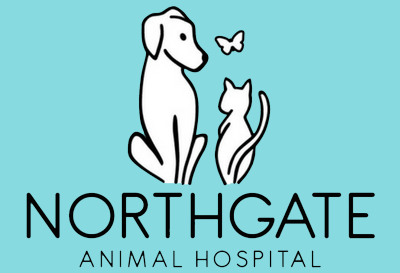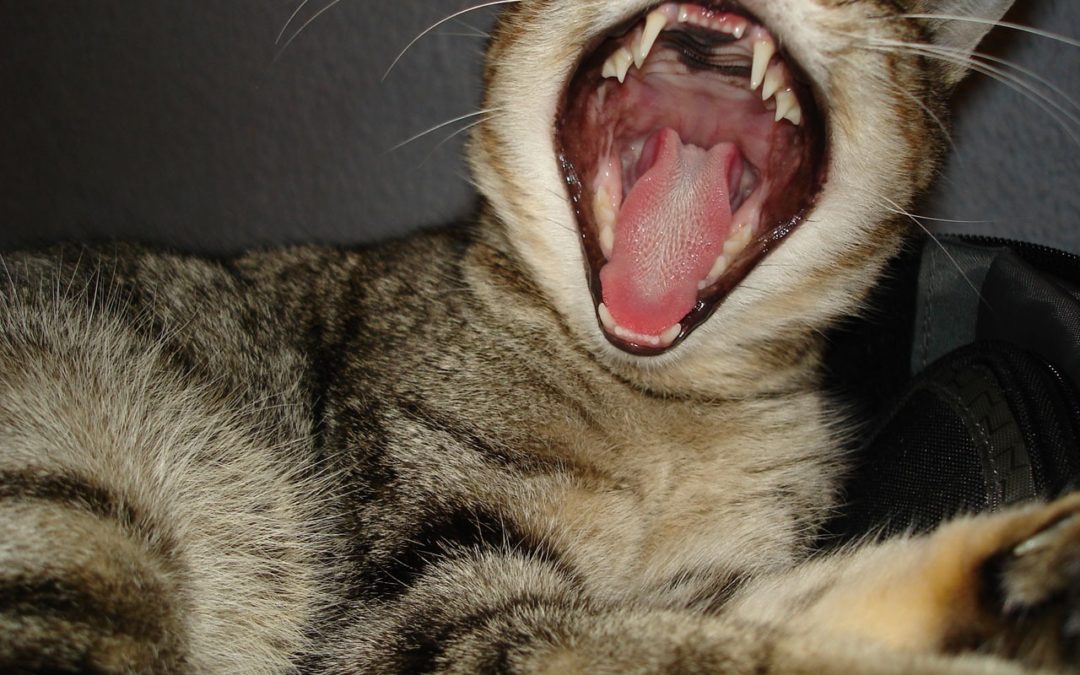We begin with a complete Physical Exam in order to evaluate your furry friend’s overall Physical Health and as an initial assessment of his/her Dental Health. Most adult dogs and cats need prophylactic dental cleanings yearly. However each patient is different and we will make our recommendations based on the oral health status of each individual patient.
On the day of your companion’s scheduled dental prophylaxis/exam/treatment, you will drop your companion off in the morning of his/her scheduled dental and they will be ready to go home late the same afternoon.
In order to be thorough and effective, teeth cleaning must be performed under anesthesia, a complete blood panel will also be used to further evaluate our patient’s vital organ status.
In preparation for anesthesia your pet will receive pre-anesthetic medications to provide relaxation and initial comfort management.
An intravenous (IV) catheter is placed for instant and painless access for additional injectable medications to induce anesthesia and provide pharmaceutical support throughout anesthesia administration. Additionally this IV catheter allows us to deliver IV fluids throughout the procedure which are a cornerstone to vital organ support during anesthesia.
Anesthesia is maintained with Isoflurane gas and Oxygen through an endotracheal tube. Extensive monitoring throughout the procedure includes: ECG for heart activity, Blood Pressure, Blood Oxygen levels, Respiratory status and Temperature. All parameters are used to ensure the best support and comfort throughout anesthesia.
Throughout anesthetic procedures we must often adjust levels of gas anesthesia, IV fluid administration rate, and administer supportive medications in response to changes in our patient’s status as detected by our many monitoring devices. Without the diligent use of monitoring equipment and direct hands-on monitoring of vital body functions, many important changes in the status of our patient would not be detected and corrected.
Anesthesia can cause a significant decrease in core body temperature. Maintaining a good body temperature is important for organ function as well as your companion’s comfort. We use a multi-layer approach to best maintain core body temperature during anesthesia. We start with a continually circulating warm water mattress maintained at safe and effective levels, the next layer is soft blanket on which your companion will lie, and a top blanket, a Bair Hugger warm air blanket is then placed over your furry friend with a final covering over the Bair Hugger to keep all the warmth with your companion. As we monitor temperature throughout anesthesia we find this to be a very effective method to keep your companion warm during surgery which is vital for maintaining a safer anesthetic protocol, and for a quick, smooth, comfortable recovery.
Once all vital body function monitoring equipment, IV fluids, and warming systems are in place a veterinary technician begins to clean off all plaque, tartar and debris from each tooth. This cleaning involves hand scaling as well as ultrasonic scaling. Anesthesia is required for this cleaning as it is vital for your furry friend’s dental health to clean all tartar from the crown of each tooth and especially under the gum-line. This under the gumline cleaning is the most important part to preventative dentistry to maintain healthy teeth, a healthy mouth, a healthy body and a happy companion.
Once the teeth are individually and thoroughly cleaned on all surfaces including under the gum-line, the technician takes full mouth digital X-rays of all teeth present, even missing crowns. Digital X-rays allow us to obtain faster, much more accurate images than regular film and allow us to adjust the images on the computer for optimal image interpretation. X-rays are crucial to evaluate the health of the root and jaw bone and ensure that missing crowns do not have retained roots hidden in the jaw bone under the gum tissue in the area of an apparently missing tooth. Retained roots can cause infection, pain and inflammation to the immediately surrounding bone as well as spread infection to adjacent teeth.
Once full mouth X-rays are complete, the doctor will visually assess each tooth and measure the gingival depth around each tooth. Each tooth evaluation is charted by a technician as apparently normal or with specific notes for abnormalities. Any tooth defects, or gingival pockets greater than 3mm, will require treatment. Abnormal pocketing around a tooth is caused by periodontal disease (root infection). Some pockets can be treated with a deep cleaning and antibiotics, but pockets greater than 6mm will often require more significant treatment and even possible extraction of the diseased tooth.
The attending veterinarian will then assess each tooth on the digital X-rays.
Each tooth evaluation is charted by a technician as apparently normal or with specific notes for abnormalities. X-rays can show us significant and painful dental disease below the gum-line that we often cannot see on visual evaluation. Root tip abscesses, sub-gingival foot fractures, retained roots, jaw bone disease and even tumors are frequently found after evaluating the dental X-rays.
Appropriate treatments for each tooth are charted, and a complete estimate is prepared and presented to you via a telephone call if the treatment is beyond the initial assessment/estimate discussed during your companion’s initial evaluation in the exam room.
Treatments can include bonded sealants for worn teeth which provide an approximate 6 month bandaid for the body to repair the tooth with a protective layer of enamel over exposed, vulnerable, painful dentin. Teeth become worn due to excessive chewing/retrieving or chipped due to trauma and aggressive chewing.
Chips/closed fractures above the gum-line that have not exposed the root cavity and have normal X-rays are excellent candidates for a bonded sealant. The purpose of the bonded sealant is to minimize chance of infection due to bacteria traveling down a root through exposed/porous dentin and eliminate pain of sensitive exposed dentin, with the ultimate goal of saving a tooth from infection and possible extraction in the future.
Some pockets due to gum tissue overgrowth can be treated by performing a gingivectomy (trimming the excessive gum tissue) and thoroughly cleaning the tooth surface now exposed to a healthy level.
Dogs rarely have what we think of as cavities and even in these rare cases fillings are not successful. Canine dental disease tends to be periodontal infection affecting the ligaments, roots and jaw bone around teeth which requires extraction of the teeth to remove and cure the infection. Referral to a veterinary dental specialist will be offered for the option of treating a major diseased tooth with a root canal e.g. a canine (fang) tooth if you wish to save the tooth rather than extract it. This is a very effective treatment to save major teeth, however it is a significant financial cost.
Cats are highly prone to lesions similar to what we think of as cavities and unfortunately are not treatable with fillings. Even a pinpoint lesion is very painful for cats and requires extraction of the diseased tooth. Cats are also very susceptible to periodontal disease and require extraction of the diseased teeth.
Appropriate treatment of each tooth individually and comprehensive full mouth treatment is critical to minimize spread of dental disease to healthy teeth. All extraction sites are shaped for a comfortable bone surface and gum tissue is sutured for rapid and optimal healing.
Extraction of one or more teeth may be concerning to you as an owner as you worry for your furry friend’s comfort during and immediately after surgery as well as his/her ability to eat in the future. Infected teeth are useless for eating and very painful. A dog or cat will however continue to eat to the best of their ability, often without showing signs of pain, until the disease is severe and even life threatening. Diseased teeth are a painful part of one our furry friend’s favorite past times – eating! Fortunately it is the removal of the infected painful teeth, effective post-operative antibiotics and excellent comfort/pain management that allows your pet to be feeling happy, healthy, active, and comfortable within 2-3 days of surgery. Cats and dogs will be able to eat whichever food they prefer (dry or canned) after an initial healing period of 2-3 weeks. Many times we hear a treated companion is acting like a puppy or kitten again after a long time of slow decline or even seemingly “normal” life. It is also important to remember dogs have 42 teeth and cats have 30 teeth!
If your furry friend has to have teeth extracted we will send them home with 2 weeks of antibiotics and comfort/pain medication. Soft food, and no chew toys, is necessary for gums to heal over a 2-3 week period and then they may return to their regular diet.
Thorough, preventative and proactive dental treatment will help ensure a healthy, comfortable, happy quality of life for your companion. Consistent and appropriate dental care will literally add years to your furry friend’s life and the time you each are lucky enough to share!
Click here for great information regarding dental care and dental diets and treats.






